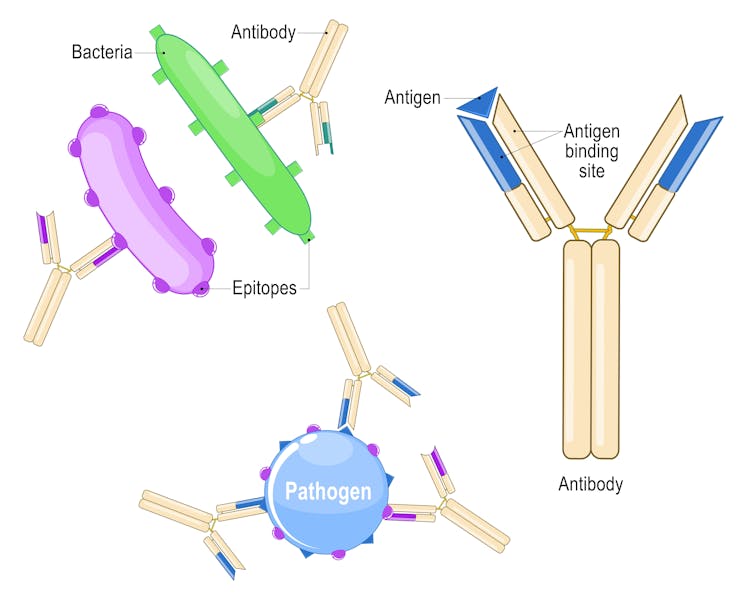Are twins allergic to the same things?
- Twins are more likely to share allergies due to their shared genetics and growing up together.
- Allergies are caused by a combination of someone’s genes and the environment they live in, making it possible for twins to develop similar allergies.
- Research has shown that identical twins are more likely to share allergies than fraternal twins, with 60-70% of twins having environmental allergies.
- The likelihood of developing an allergy is influenced by factors such as hygiene, exposure to different bacteria, and genetics, which can affect whether twins develop the same or different allergies.
- While twins may be more likely to share allergies, it’s not a guarantee that they will have identical allergies, and individual experiences can vary greatly depending on their unique circumstances.

Curious Kids is a series for children of all ages. If you have a question you’d like an expert to answer, send it to curiouskidsus@theconversation.com.
Are twins allergic to the same things? – Ella, age 7, Philadelphia
Allergies, whether spring sneezes due to pollen or trouble breathing triggered by a certain food, are caused by a combination of someone’s genes and the environment they live in.
The more things two people share, the higher their chances of being allergic to the same things. Twins are more likely to share allergies because of everything they have in common, but the story doesn’t end there.
I’m an allergist and immunologist, and part of my job is treating patients who have environmental, food or drug allergies. Allergies are really complex, and a lot of factors play a role in who gets them and who doesn’t.
What is an allergy?
Your immune system makes defense proteins called antibodies. Their job is to keep watch and attack any invading germs or other dangerous substances that get inside your body before they can make you sick.
An allergy happens when your body mistakes some usually harmless substance for a harmful intruder. These trigger molecules are called allergens.

ttsz/iStock via Getty Images Plus
The antibodies stick like suction cups to the allergens, setting off an immune system reaction. That process leads to common allergy symptoms: sneezing, a runny or stuffy nose, itchy, watery eyes, a cough. These symptoms can be annoying but minor.
Allergies can also cause a life-threatening reaction called anaphylaxis that requires immediate medical attention. For example, if someone ate a food they were allergic to, and then had throat swelling and a rash, that would be considered anaphylaxis.
The traditional treatment for anaphylaxis is a shot of the hormone epinephrine into the leg muscle. Allergy sufferers can also carry an auto-injector to give themselves an emergency shot in case of a life-threatening case of anaphylaxis. An epinephrine nasal spray is now available, too, which also works very quickly.
A person can be allergic to things outdoors, like grass or tree pollen and bee stings, or indoors, like pets and tiny bugs called dust mites that hang out in carpets and mattresses.
A person can also be allergic to foods. Food allergies affect 4% to 5% of the population. The most common are to cow’s milk, eggs, wheat, soy, peanuts, tree nuts, fish, shellfish and sesame. Sometimes people grow out of allergies, and sometimes they are lifelong.
Who gets allergies?
Each antibody has a specific target, which is why some people may only be allergic to one thing.
The antibodies responsible for allergies also take care of cleaning up any parasites that your body encounters. Thanks to modern medicine, people in the United States rarely deal with parasites. Those antibodies are still ready to fight, though, and sometimes they misfire at silly things, like pollen or food.
Hygiene and the environment around you can also play a role in how likely it is you’ll develop allergies. Basically, the more different kinds of bacteria that you’re exposed to earlier in life, the less likely you are to develop allergies. Studies have even shown that kids who grow up on farms, kids who have pets before the age of 5, and kids who have a lot of siblings are less likely to develop allergies. Being breastfed as a baby can also protect against having allergies.
Children who grow up in cities are more likely to develop allergies, probably due to air pollution, as are children who are around people who smoke.
Kids are less likely to develop food allergies if they try foods early in life rather than waiting until they are older. Sometimes a certain job can contribute to an adult developing environmental allergies. For example, hairdressers, bakers and car mechanics can develop allergies due to chemicals they work with.
Genetics can also play a huge role in why some people develop allergies. If a mom or dad has environmental or food allergies, their child is more likely to have allergies. Specifically for peanut allergies, if your parent or sibling is allergic to peanuts, you are seven times more likely to be allergic to peanuts!

Ronnie Kaufman/DigitalVision via Getty Images Plus
Identical in allergies?
Back to the idea of twins: Yes, they can be allergic to the same things, but not always.
Researchers in Australia found that 60% to 70% of twins in one study both had environmental allergies, and identical twins were more likely to share allergies than fraternal (nonidentical) twins. Identical twins share 100% of their genes, while fraternal twins only share about 50% of their genes, the same as any pair of siblings.
A lot more research has been done on the genetics of food allergies. One peanut allergy study found that identical twins were more likely to both be allergic to peanuts than fraternal twins were.
So, twins can be allergic to the same things, and it’s more likely that they will be, based on their shared genetics and growing up together. But twins aren’t automatically allergic to the exact same things.
Imagine if two twins are separated at birth and raised in different homes: one on a farm with pets and one in the inner city. What if one’s parents smoke, and the others don’t? What if one lives with a lot of siblings and the other is an only child? They certainly could develop different allergies, or maybe not develop allergies at all.
Scientists like me are continuing to research allergies, and we hope to have more answers in the future.
Hello, curious kids! Do you have a question you’d like an expert to answer? Ask an adult to send your question to CuriousKidsUS@theconversation.com. Please tell us your name, age and the city where you live.
And since curiosity has no age limit – adults, let us know what you’re wondering, too. We won’t be able to answer every question, but we will do our best.
![]()
Breanne Hayes Haney does not work for, consult, own shares in or receive funding from any company or organization that would benefit from this article, and has disclosed no relevant affiliations beyond their academic appointment.
